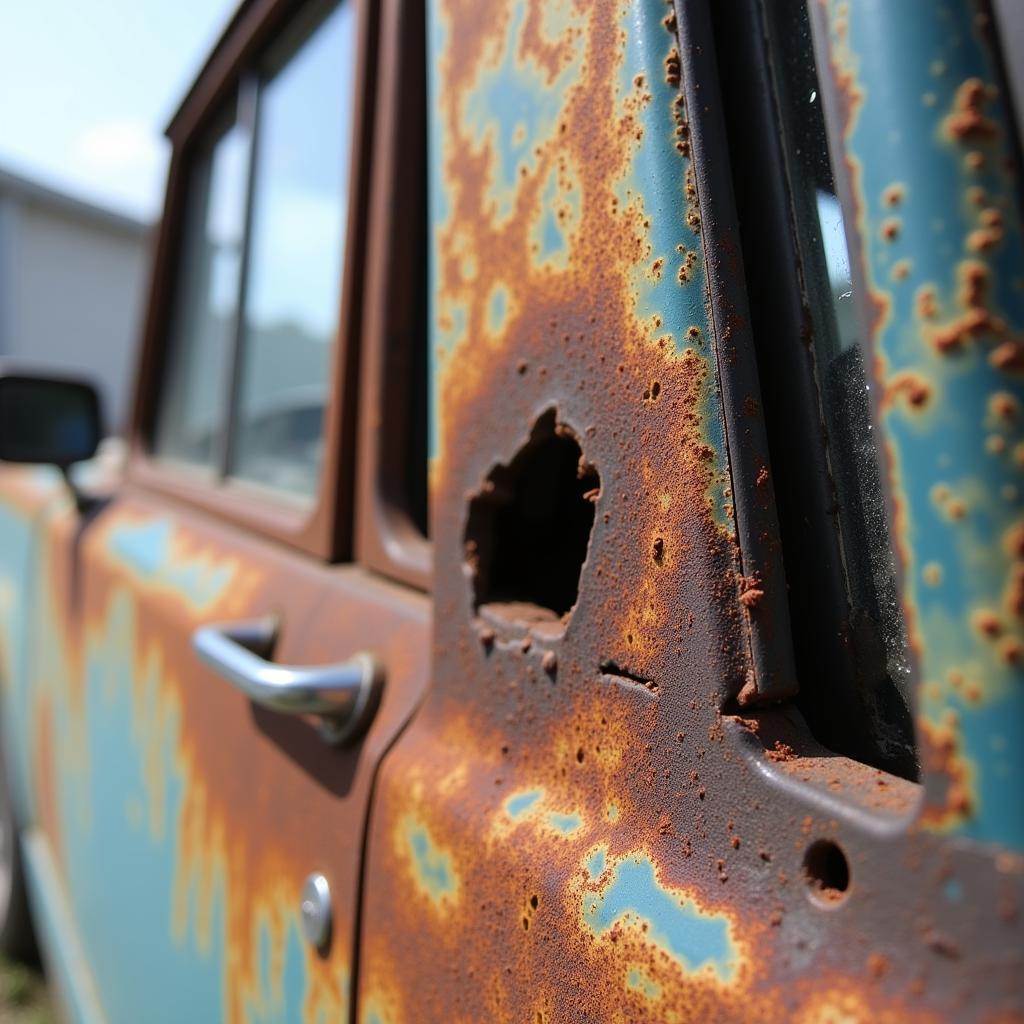Rust holes around car windows are a common problem, especially in older vehicles or those exposed to harsh weather conditions. Ignoring these rust holes can lead to further damage and compromise the structural integrity of your car. Luckily, fixing a car rust hole window isn’t always a job for a professional. With the right tools and a little patience, you can tackle this repair yourself and prevent further deterioration.
Similar to fixing a damaged roof on a car, addressing rust promptly is crucial. This guide will provide a step-by-step approach to effectively Fix Car Rust Hole Window issues, ranging from small surface rust to more substantial holes. We’ll cover everything from the necessary tools and materials to the detailed repair process.
Assessing the Damage: How Bad is the Rust?
Before you begin, you need to assess the extent of the rust damage. Is it just surface rust, or has it eaten through the metal? This will determine the approach you need to take. Surface rust can often be treated with a rust converter, while larger holes will require patching or even welding. Accurately identifying the damage level is the first step to a successful repair.
What causes car rust around windows? Moisture, salt, and road debris can accumulate in the window channels and crevices, creating the perfect environment for rust to form. Prevention is key, and we’ll discuss preventative measures later in this guide.
Gathering Your Tools and Materials: Be Prepared
Having the right tools and materials will make the repair process much smoother. You’ll need:
- Sandpaper (various grits)
- Rust converter
- Body filler (Bondo)
- Primer
- Paint (matching your car’s color)
- Masking tape and paper
- Safety glasses and gloves
- Wire brush or drill attachment
- Metal sheeting (if patching is required)
- Welding equipment (if welding is necessary)
Don’t underestimate the importance of proper preparation. Having everything ready will save you time and frustration.
 Assessing Car Rust Hole Window Damage
Assessing Car Rust Hole Window Damage
Step-by-Step Rust Repair Guide: From Prep to Paint
- Prepare the area: Clean the rusted area thoroughly with a wire brush or drill attachment to remove loose rust and paint. This will ensure proper adhesion of the rust converter and body filler.
- Apply rust converter: If you’re dealing with surface rust, apply a rust converter to the affected area. This will chemically convert the rust into a stable compound and prevent further rusting.
- Fill the hole (if necessary): If there’s a hole, use a piece of metal sheeting to patch it. Secure the patch with body filler or by welding. For larger holes, welding may be the better option. This process is similar to fixing a damaged roof on a car where patching or replacement might be necessary.
- Apply body filler: Smooth out the patched area or any uneven surfaces with body filler. Apply thin coats, allowing each coat to dry before sanding.
- Sand and prime: Sand the filled area smooth with progressively finer grits of sandpaper. Once smooth, apply a coat of primer to prepare the surface for painting.
- Paint and finish: Apply several thin coats of paint that matches your car’s color, allowing each coat to dry before applying the next. Finish with a clear coat for added protection.
 Applying Body Filler to a Car Rust Repair
Applying Body Filler to a Car Rust Repair
Preventing Future Rust: Proactive Measures
Preventing rust is always better than dealing with it after it occurs. Here are some tips:
- Regularly wash and wax your car.
- Keep the window channels and crevices clean.
- Apply a rust inhibitor to vulnerable areas.
- Address any chips or scratches in the paint promptly.
By taking these preventative measures, you can significantly reduce the risk of future rust problems. Remember, a little preventative maintenance goes a long way.
Can a car with frame damage be fixed? While frame damage is a more serious issue, it can be repaired, often requiring professional intervention.
 Preventing Car Rust by Maintaining Window Seal
Preventing Car Rust by Maintaining Window Seal
Frequently Asked Questions
- How much does it cost to fix a car rust hole window? The cost can vary depending on the extent of the damage and whether you do it yourself or hire a professional. DIY repairs can cost anywhere from $50 to $150, while professional repairs can range from $200 to $500 or more.
- Can I use any type of paint for my car? It’s best to use automotive paint that matches your car’s color for a seamless repair.
- What if the rust is on the inside of the door? Rust on the inside of the door is often more complex and may require removing the door panel for proper repair.
- How long does it take for body filler to dry? Body filler typically dries within 30 minutes to an hour, depending on the temperature and humidity.
- Is welding always necessary for rust repair? Welding is only necessary for larger rust holes that require patching with metal sheeting.
- How can I find a reliable auto body repair shop? Check online reviews and ask for recommendations from friends or family. Car fix services are readily available, but finding a reputable one is key.
Conclusion
Fixing a car rust hole window is a manageable task that can save you money and prevent further damage. By following the steps outlined in this guide, you can achieve professional-looking results. Remember to address rust issues promptly and take preventative measures to protect your car from future rust problems. For professional assistance or additional guidance, feel free to connect with AutoTipPro at +1 (641) 206-8880 or visit our office at 500 N St Mary’s St, San Antonio, TX 78205, United States.
If you’re dealing with a leaky car door window seal, fixing it is essential to prevent water damage and rust.




Leave a Reply